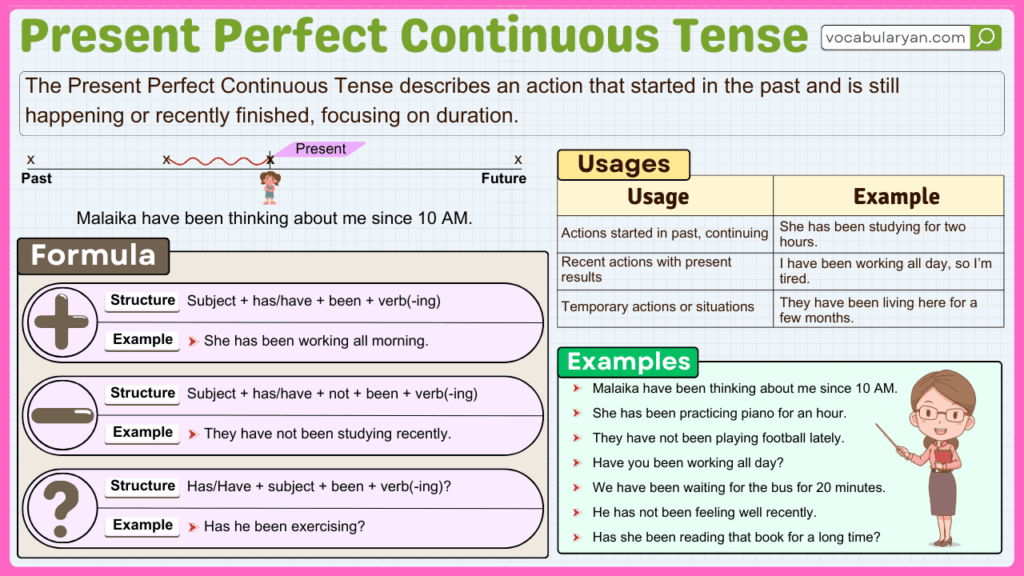Learning the Present Continuous tense is essential for describing actions happening right now or around the current time. It is formed using am/is/are + verb + -ing, for example, “She is reading a book” or “They are playing football.” This tense also expresses planned future activities. Mastering the Present Continuous tense helps you communicate ongoing actions clearly and naturally in everyday conversations and writing.
Structures of the Tense
The Present Continuous Tense follows this base structure:
Subject + am / is / are + base verb + ing
Affirmative Sentences
Structure: Subject + am / is / are + verb-ing
Examples:
- I am studying English.
- They are playing football.
Negative Sentences
Structure: Subject + am / is / are + not + verb-ing
Examples:
- She is not watching TV.
- We are not working today.
Interrogative Sentences
Structure: Am / Is / Are + subject + verb-ing
Examples:
- Are you learning grammar?
- Is he coming to school?
Double Interrogative Sentences
Structure: Wh-word + am / is / are + subject + verb-ing
Examples:
- What is she reading?
- Why are they shouting?
Subject–Verb Agreement
This table shows how different subjects match with the helping verbs in the Present Continuous Tense:
| Subject | Helping Verb |
|---|---|
| I | am |
| He (doctor) | is |
| She (teacher) | is |
| My father | is |
| It (dog) | is |
| You | are |
| We (students) | are |
| They (engineers) | are |
| Dogs | are |
Time Expressions
These time words are commonly used with the Present Continuous Tense, showing when the action is happening:
- Now: I am cooking now.
- At the moment: She is calling you at the moment.
- Currently: He is currently working from home.
- Right now: We are learning English right now.
- Today: They are not attending school today.
- This week: I am staying in Lahore this week.
- Nowadays: People are using smartphones more nowadays.
- Still: He is still waiting for the bus.
Adverb Placement
In Present Continuous Tense, adverbs of frequency or manner (such as always, still, just) are placed between the helping verb and the main verb.
- She is always forgetting her keys.
- I am still working on the assignment.
- We are just leaving the house.
Uses of Present Continuous Tense
The Present Continuous Tense is used for a variety of purposes, from basic communication to advanced usage. Understanding all its uses helps learners apply it correctly.
- Actions happening at the moment of speaking
- He is talking on the phone.
- Temporary actions or situations
- I am staying with a friend this week.
- Planned future actions (scheduled or arranged)
- We are meeting the manager tomorrow.
- Repeated actions with annoyance or emphasis
- She is always complaining about the food.
- Changing or developing situations
- The climate is getting warmer.

Short Answers
Short answers are used to respond to yes or no questions briefly and politely.
| Question | Short Answer |
|---|---|
| Are you studying? | Yes, I am. |
| Is he eating? | No, he is not. |
| Are we going now? | Yes, we are. |
| Is your father sleeping? | No, he is not. |
| Are they working on the project? | Yes, they are. |
Question Tags
Question tags are used at the end of statements to confirm or check information. They reflect the helping verb of the main sentence.
| Sentence | Question Tag |
|---|---|
| She is watching a movie | isn’t she |
| You are leaving soon | aren’t you |
| We are learning grammar | aren’t we |
| He is not coming today | is he |
| They are studying hard | aren’t they |
Examples of Present Continuous Tense
This section provides practical exposure to how the Present Continuous Tense is used in real contexts. Below are twelve examples:
Affirmative Sentences:
- I am reading a novel.
- They are playing outside.
- She is cooking dinner.
- We are preparing for the exam.
- He is writing a letter.
Common Mistakes with Present Continuous Tense
Many learners make errors when using the Present Continuous Tense. This section helps you understand the most common problems and how to correct them.
| Common Mistake | Correct Usage |
|---|---|
| He working now | He is working now |
| I am go to school | I am going to school |
| Are she coming today | Is she coming today |
| They is playing cricket | They are playing cricket |
| We not are watching TV | We are not watching TV |
You May Also Like




Leave a Comment